
Metra is the primary commuter rail system in the Chicago metropolitan area serving the city of Chicago and its surrounding suburbs via the Union Pacific Railroad, BNSF Railway, and other railroads. The system operates 242 stations on 11 rail lines. It is the fourth busiest commuter rail system in the United States by ridership and the largest and busiest commuter rail system outside the New York City metropolitan area. In 2023, the system had a ridership of 31,894,900, or about 152,400 per weekday as of the fourth quarter of 2023. The estimated busiest day for Metra ridership occurred on November 4, 2016—the day of the Chicago Cubs 2016 World Series victory rally.
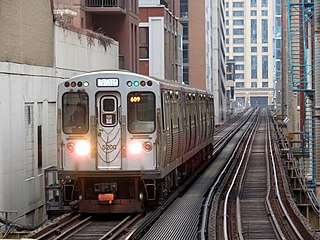
The Green Line is a rapid transit line in Chicago, Illinois, operated by the Chicago Transit Authority (CTA) as part of the Chicago "L" system. It is the only completely elevated route in the "L" system. All other routes may have various combinations of elevated, subway, street level, or freeway median sections.

The Illinois Central Railroad, sometimes called the Main Line of Mid-America, was a railroad in the Central United States. Its primary routes connected Chicago, Illinois, with New Orleans, Louisiana, and Mobile, Alabama, and thus, the Great Lakes to the Gulf of Mexico. Another line connected Chicago west to Sioux City, Iowa (1870), while smaller branches reached Omaha, Nebraska (1899) from Fort Dodge, Iowa, and Sioux Falls, South Dakota (1877), from Cherokee, Iowa. The IC also ran service to Miami, Florida, on trackage owned by other railroads.
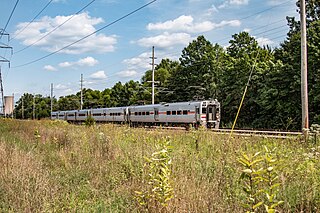
The South Shore Line is an electrically powered interurban commuter rail line operated by the Northern Indiana Commuter Transportation District (NICTD) between Millennium Station in downtown Chicago and the South Bend International Airport in South Bend, Indiana, United States. The name refers to both the physical line and the service operated over that route. The line was built in 1901–1908 by predecessors of the Chicago South Shore and South Bend Railroad, which continues to operate freight service. Passenger operation was assumed by the NICTD in 1989, who also purchased the track in 1990. The South Shore Line is one of the last surviving interurban trains in the United States. In 2023, the system had a ridership of 1,406,900, or about 5,000 per weekday as of the fourth quarter of 2023.

Millennium Station is a major commuter rail terminal in the Loop (downtown), Chicago. It is the northern terminus of the Metra Electric District to Chicago's southern suburbs, and the western terminus of the South Shore Line to Gary and South Bend, Indiana.

The Union Pacific North Line (UP-N) is a Metra line in the Chicago metropolitan area. It runs between Ogilvie Transportation Center and Kenosha, Wisconsin; however, most trains terminate in Waukegan, Illinois. Although Metra owns the rolling stock, the trains are operated and dispatched by the Union Pacific Railroad. This line was previously operated by the Chicago & North Western Railway before its merger with the Union Pacific Railroad, and was called the Chicago and North Western Milwaukee Division and then the Chicago & North Western/North Line before the C&NW was absorbed by Union Pacific in April 1995. It is the only Metra line that travels outside Illinois.

The Union Pacific West Line (UP-W) is a Metra commuter rail line operated by Union Pacific Railroad in Chicago, Illinois and its western suburbs. Metra does not refer to its lines by particular colors, but the timetable accents for the Union Pacific West line are "Kate Shelley Rose" pink, honoring an Iowa woman who saved a Chicago & North Western Railway train from disaster in 1881. Green and yellow were already selected for the Union Pacific North Line and Union Pacific Northwest Line, respectively, so pink was chosen for this line. Therefore, the UP-W is the only Metra line that uses a color to honor a person instead of a fallen flag railroad. Until the late 1940s the line had a branch to Freeport, Illinois. It diverged from the main line at West Chicago and had stations at Elgin, Marengo, Belvidere, Rockford, Freeport, and other communities. The line was once known as the Chicago & Northwestern/West Line until UP took over the C&NW in 1995. All Metra trains on this line terminated at Geneva until 2006, when the line was extended to its present terminus in Elburn. The line runs as part of the Union Pacific Railroad's Geneva Subdivision.

The Union Pacific Northwest Line (UP-NW) is a commuter rail line provided by Metra and operated by the Union Pacific Railroad in Chicago, Illinois and its surrounding suburbs. While Metra does not refer to any of its lines by colors, the timetable accents for the Union Pacific Northwest Line are bright "Viking Yellow," honoring the Chicago & North Western Railway's Viking passenger train.

The BNSF Line is a Metra commuter rail line operated by the BNSF Railway in Chicago and its western suburbs, running from Chicago Union Station to Aurora, Illinois. In 2010, the BNSF Line continued to have the highest weekday ridership of the 11 Metra lines. While Metra does not refer to its lines by particular colors, the BNSF line's color on Metra timetables is "Cascade Green," in honor of the Burlington Northern Railroad.

The North Central Service (NCS) is a Metra commuter rail line running from Union Station in downtown Chicago through northwestern and far northern suburbs to Antioch, Illinois. In December 2022, the public timetable shows seven weekday departures from Chicago. This line does not run at all on weekends or holidays. While Metra does not explicitly refer to any of its eleven routes by colors, the NCS' timetable accents are lavender, a shade of purple. It is one of two Metra lines that do not have a specific color for a fallen flag railroad that used to operate on the route.
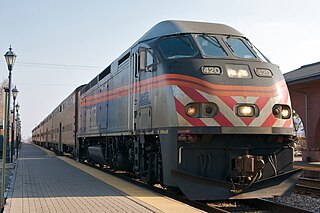
The Milwaukee District West Line (MD-W) is a Metra commuter rail line in Chicago, Illinois, and its western suburbs. Metra does not refer to any of its lines by a particular color, but the timetable accents for the Milwaukee District West line are dark "Arrow Yellow," honoring the Milwaukee Road's Arrow passenger train. Trains are dispatched from the Canadian Pacific Kansas City Railway's American headquarters in Minneapolis.

The Heritage Corridor (HC) is a Metra commuter rail line in Chicago, Illinois, and its southwestern suburbs, terminating in Joliet, Illinois. While Metra does not refer to its lines by colors, the Heritage Corridor appears on Metra timetables as "Alton Maroon," after the Alton Railroad, which ran trains on this route. The name Heritage Corridor refers to the Illinois and Michigan Canal Heritage Corridor. Established in 1984, it runs parallel to the line.

The SouthWest Service (SWS) is a Metra commuter rail line, running southwest from Union Station in downtown Chicago, Illinois, to Manhattan, Illinois. Metra does not refer to its lines by color, but the timetable accents for the SouthWest Service line are "Banner Blue," for the Wabash Railroad's Banner Blue passenger train. The trackage is owned by Metra north of a junction with the Belt Railway of Chicago at Loomis Boulevard, and is leased from Norfolk Southern Railway south of the junction.

The Rock Island District (RI) is a Metra commuter rail line from Chicago, Illinois, southwest to Joliet. Metra does not refer to its lines by color, but the timetable accents for the Rock Island District line are "Rocket Red" in honor of the Chicago, Rock Island and Pacific Railroad's Rocket passenger trains.
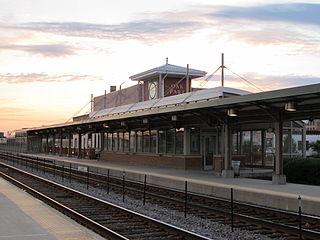
Oak Park is a Metra commuter railroad station in Oak Park, Illinois, just west of Chicago. It is served by Metra's Union Pacific West Line, with service east to Ogilvie Transportation Center in Chicago and as far west as Elburn, Illinois. Travel time to Chicago is 16 to 20 minutes. As of 2018, Oak Park is the 52nd busiest of the 236 non-downtown stations in the Metra system, with an average of 991 weekday boardings. It is the final stop for most UP West trains before the terminus at Ogilvie Transportation Center. Unless otherwise announced, inbound trains use the north (side) platform and outbound trains use the south (island) platform.

Museum Campus/11th Street is a commuter rail station in downtown Chicago that serves the Metra Electric Line north to Millennium Station and south to University Park, Blue Island and South Chicago; and the South Shore Line to Gary and South Bend, Indiana.
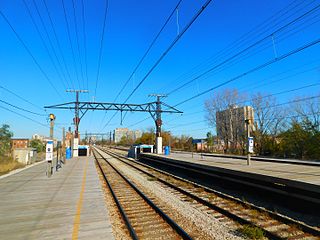
63rd Street station is a commuter rail station within the city of Chicago that serves the Metra Electric Line north to Millennium Station and south to University Park, Blue Island, and the Chicago neighborhood of South Chicago and the South Shore Line to Gary and South Bend, Indiana. Most South Shore Line trains do not stop at this station, except for one inbound train during the AM rush and two outbound trains during the PM rush on weekdays. As of 2018, the station is the 169th busiest of Metra's 236 non-downtown stations, with an average of 167 weekday boardings.

The Highliner is a bilevel electric multiple unit (EMU) railcar. The original series of railcars were built in 1971 by the St. Louis Car Company for commuter service on the Illinois Central Railroad, in south Chicago, Illinois, with an additional batch later produced by Bombardier. A second generation featuring a completely new design was produced by Nippon Sharyo beginning in 2005.

Blue Island–Vermont Street is a Metra station in Blue Island, Illinois, servicing the Rock Island District and Metra Electric District Lines. On the Rock Island, it is 16.4 miles (26.4 km) from LaSalle Street Station. For the Metra Electric, it is the southern terminus of the Blue Island Branch, and is 18.9 miles (30.4 km) from Millennium Station.

The Jefferson Park Transit Center is an intermodal passenger transport hub in the Jefferson Park neighborhood of Chicago, Illinois. It serves as a station for rail and also as a bus terminal. Jefferson Park Transit Center's railroad station is on Metra's Union Pacific Northwest Line, with the station located at 4963 North Milwaukee Avenue. Jefferson Park is 9.1 miles (14.6 km) away from Ogilvie Transportation Center in downtown Chicago, the inbound terminus of the Union Pacific Northwest Line. Under Metra's zone-based fare system, Jefferson Park is in zone 2. As of 2018, Jefferson Park is the 97th busiest of Metra's 236 non-downtown stations, with an average of 510 weekday boardings.
























